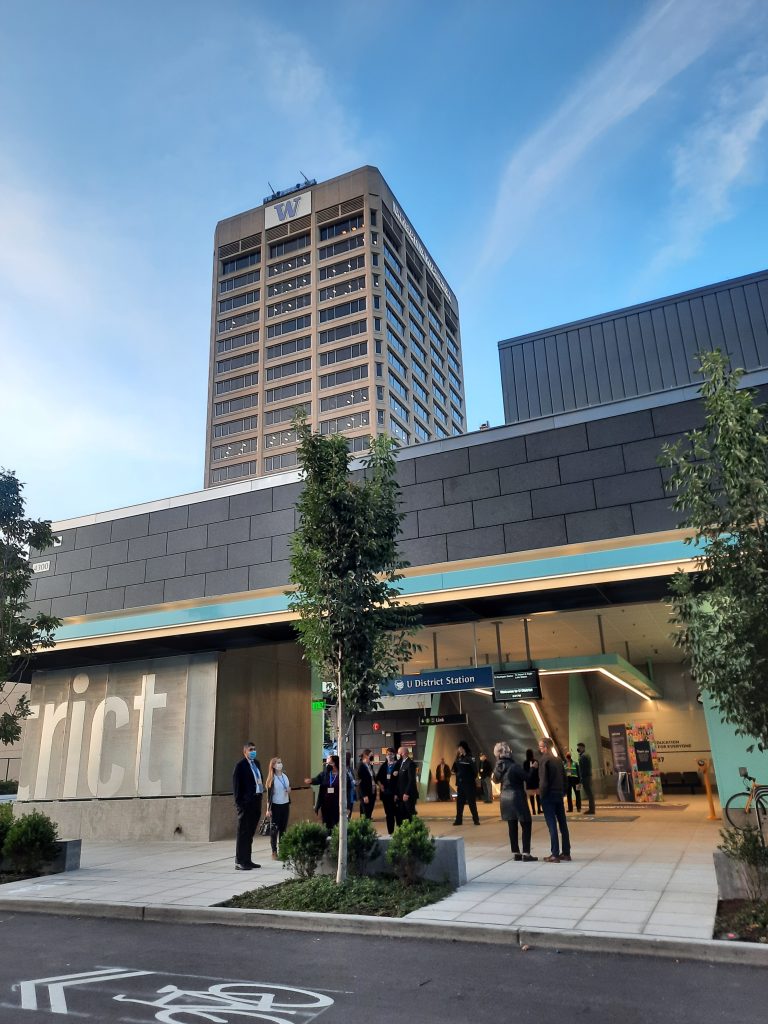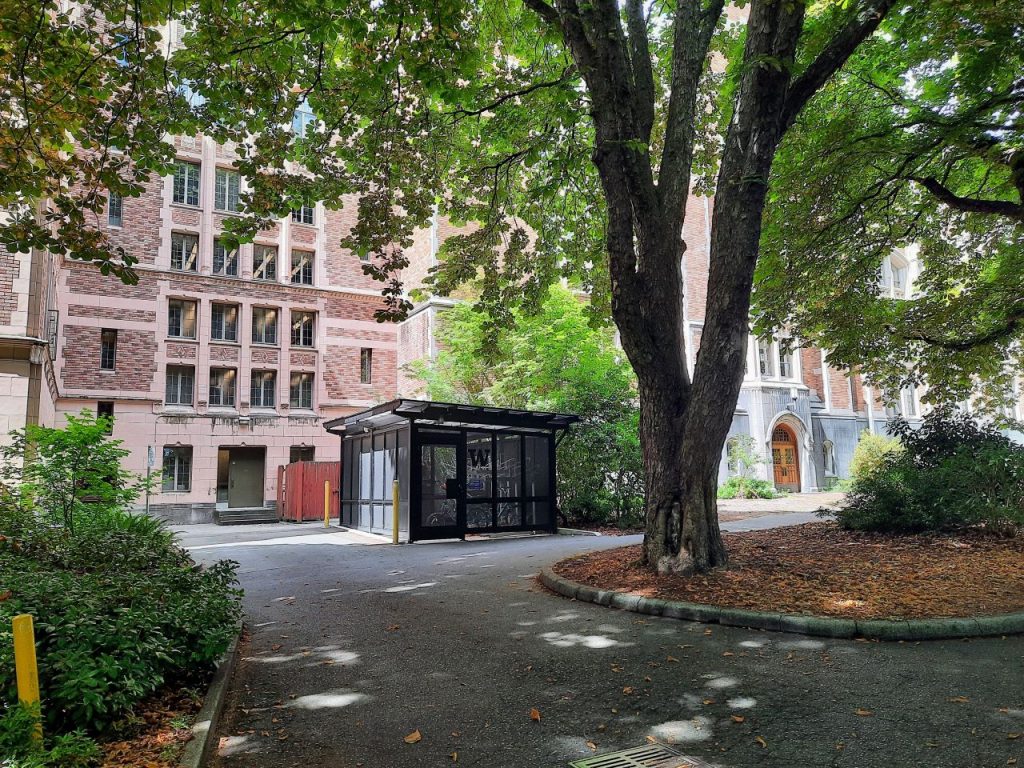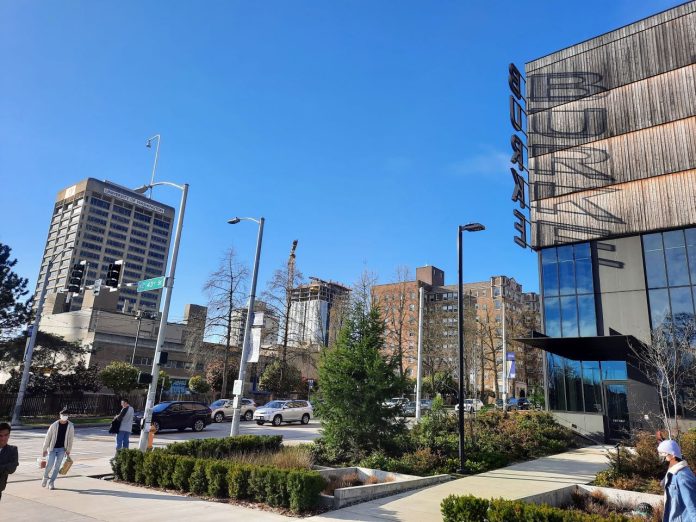
The University of Washington (UW) has been actively addressing transportation challenges inherent in operating a 60,000-student campus amidst Seattle’s already bustling street network. The vehicle which guides transportation planning is UW’s Campus Master Plan. While this plan encompasses more than transportation, this article will focus on UW and Seattle’s move towards sustainable transportation and harmonious growth despite initial concerns.
With a self-proclaimed commitment to embracing carpooling, public transit, and other eco-friendly commuting alternatives, UW continues to reduce single occupancy vehicle (SOV) commutes and improve transportation accessibility for its students.
The campus benefits from two stations of a growing light rail network that reached Northgate in 2021 and will extend to Lynnwood in 2024 and across the lake to Bellevue and Redmond in 2025. The student population is also heavily reliant on buses that have suffered some service cuts in the pandemic era. The Campus Master Plan stipulates a drive alone rate target of 15% one year after Lynnwood Link opens.
As the transportation landscape at UW evolves, students have not been silent about their experiences. Sarina Vafa, a senior at UW, told The Urbanist, “The bus is fuller this year… There are times when they don’t even let more people on.”
Megan Wong, another senior at UW, noted, “I’ve seen multiple full buses driving to campus from the U District.”
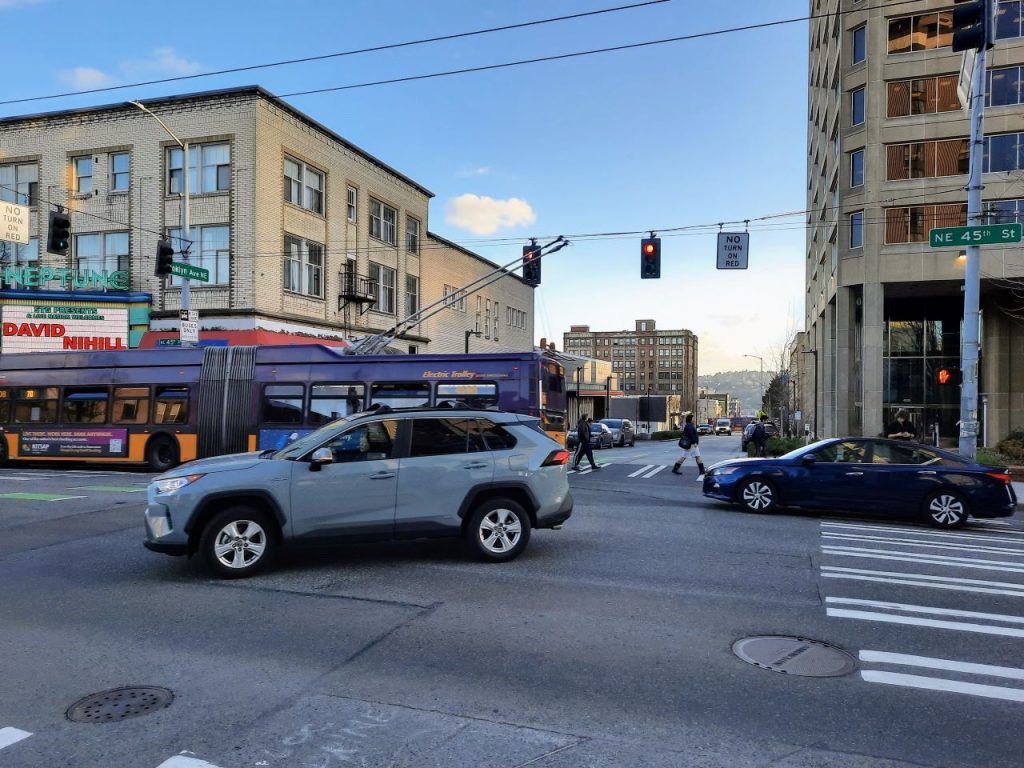
These concerns highlight the need for UW to continue to update its transportation systems to accommodate more riders. However, these student accounts also suggest that the universities’ initiative to encourage students to use the bus is working as the buses are becoming more crowded. Student anecdotes are supported by survey data, which show the university is reducing its drive alone rate and seeing a transit rebound.
In its 2023 annual report, UW reported a 13% drive alone rate for 2022 across its whole population, with walking and transit the top two ways people get to campus. About a quarter of faculty and staff drive alone, but just 8% of students do, bringing down the campus-wide average. One big change in the pandemic era: 34% of UW employees are now telecommuting which has helped decrease driving rates and student transit rates are recovering after an initial pandemic dip.
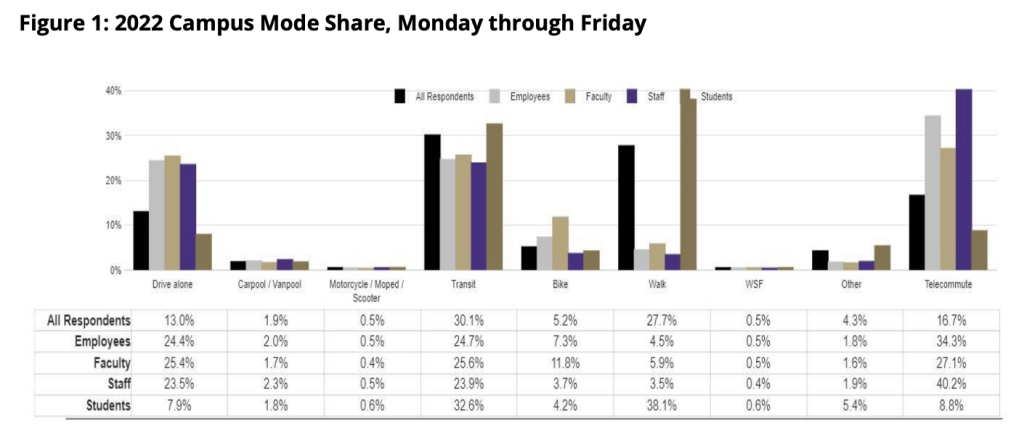
Despite the slow return to transit use post-Covid, the university has made efforts to reduce its transportation impacts, resulting in one of the lowest drive alone rates among universities nationwide. In 2019, the campus-wide drive alone rate was 18%, and UW did not list telecommuting in its mode share report.
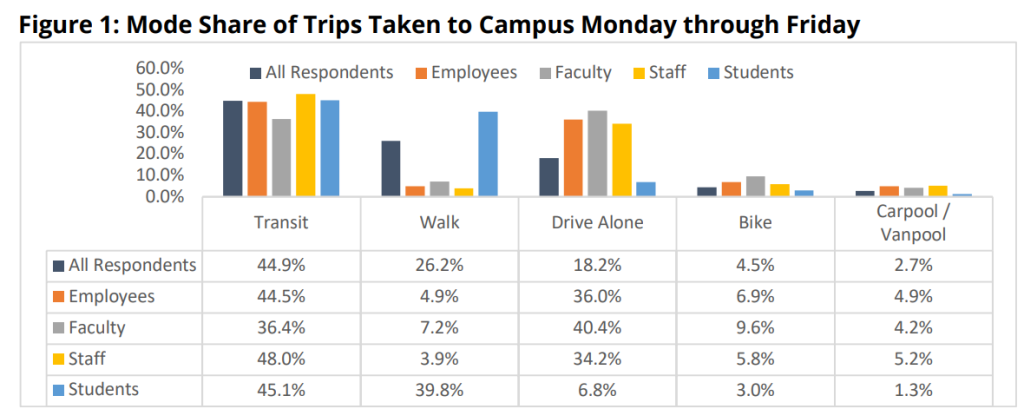
Through the UW Master Plan, UW balances campus growth and evolving transportation needs, setting targets for classroom space, greenspace, transportation mode share, and housing on campus. With an assist from the pandemic telecommuting trend, UW has achieved its drive alone target, but the university will need to ensure those gains are sustained. Student advocacy that won free transit passes for all students and staff (despite the initial reticence of the administration to do so) also helped.
Advocates Press for More Affordable, Accessible Transit
UW’s sustainable transportation achievements did not come without their share of resistance from within the university itself. The Transit Riders Union, a group dedicated to advocating for public transit, emphasized to UW the vital importance of encouraging people to shift from driving to using public transit as a key strategy to mitigate passenger transportation emissions. Katie Wilson, the general secretary of the Transit Riders Union, underlined that one of the most effective ways to promote public transit usage is for employers to provide transit passes to their employees.
“Encouraging people to make the switch from driving alone to public transit is one of the most effective things we can do to turn [passenger transportation emissions] around,” Wilson told UW Daily in 2019.
As part of this advocacy, the Transit Riders Union delivered a letter at the University of Washington’s board of regents meeting on May 9, 2018 calling on them to provide fully subsidized transit passes for UW employees (and they echoed this call in The Urbanist). Eventually, their mission ended successfully after the UW board of regents approved free U-Passes for all employees starting in July 2022. Had it not been for the efforts of this coalition, UW students and employees might not be benefitting from the free U-Pass as they do today.
Other organizations, including The Sierra Club, expressed their concerns about UW’s hesitancy to give free U-Passes to employees. In a letter addressed to the city, The Sierra Club pointed out that the rate of staff members driving alone to the university, which stood at 38% in 2002, had barely changed by 2016, remaining at 36% in 2019. This situation initially persisted even after the extension of light rail to Husky Stadium, at the edge of campus.
The Sierra Club argued that with staff represents a substantial 46% of the overall projected single-occupancy vehicle (SOV) rate in 2028, they should be the primary target for free U-Passes. In response, the university articulated that free transit passes would necessitate action from the state legislature to both mandate and allocate funding for such a program. Given UW’s ample resources, these claims appeared to be empty justifications.
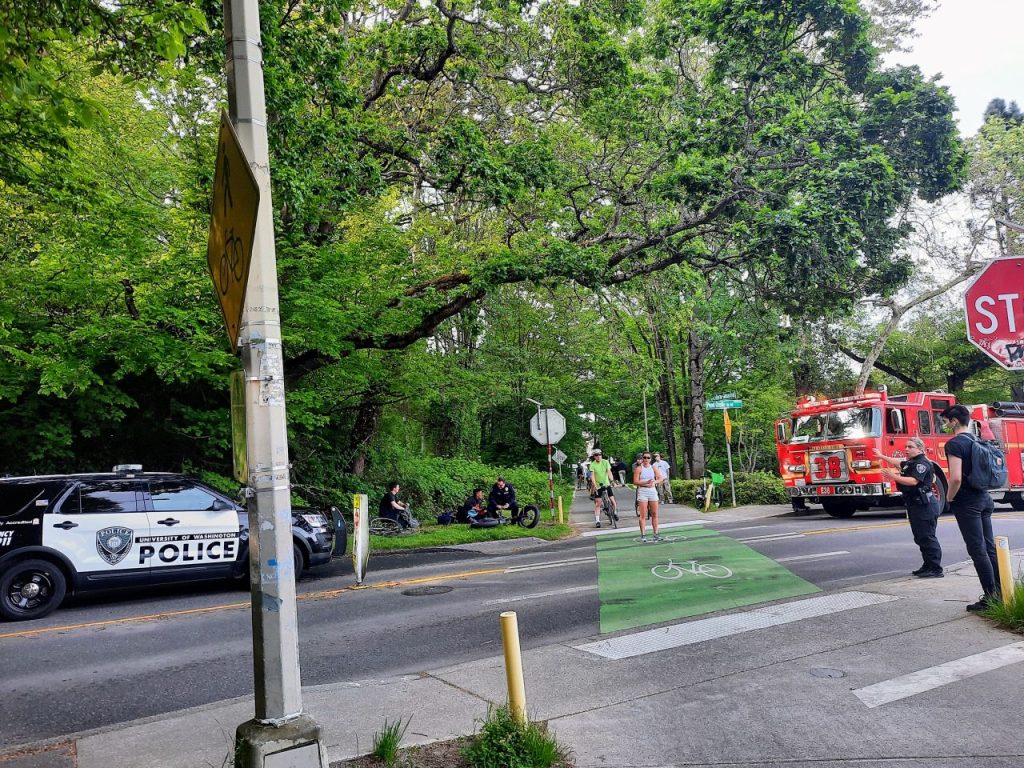
Along with concerns for the solo driver rates around UW, The Sierra Club also spoke out about UW’s parking caps. A representative for the club stated that UW’s parking cap should be reduced, which was at the time set at 12,300 spaces. He argued that the cap did not account for 750 spaces in the University of Washington Tower. Plus, this cap was established nearly 30 years ago in 1990, and that the university should adjust its parking supply to better align with current needs. Though UW eventually heeded these requests, it took almost 30 years to realize they could get by with less parking.
The movement for free U-Passes grew so popular that, in 2018, UW employees and their community allies engaged in countless advocacy efforts. This included staging rallies, disrupting traffic, composing letters, securing endorsements from elected officials, submitting petitions, and offering testimonies during meetings. Simultaneously, labor unions, such as SEIU 925 and UAW 4121, representing various sectors of the UW workforce, made transit passes a central focus during contract negotiations. Despite successfully including free U-PASS provisions in these negotiations, campus unions had to mobilize and initiate third-party grievance arbitration when the University of Washington attempted to withdraw on its commitment to extend this benefit to all eligible members.
A Plan to Enhance Commute-Trip Efficiency and Invest in Sustainability
Responding to pushback from groups like the Transit Riders Union, the Sierra Club, and the wider university community, UW has worked towards a more sustainable university. In its 2023 Master Plan, the university seeks to lower the number of solo trips by UW students and staff to 15% of vehicles within this year. This rate has already seen a drop of 5.9% since UW’s Campus Master Plan initiation. The university also pledges to maintain AM and PM trip caps to prevent peak traffic around campus. They have also implemented a parking stall cap at 9000 spots, which was achieved after a successful removal of 56 stalls compared to last year.
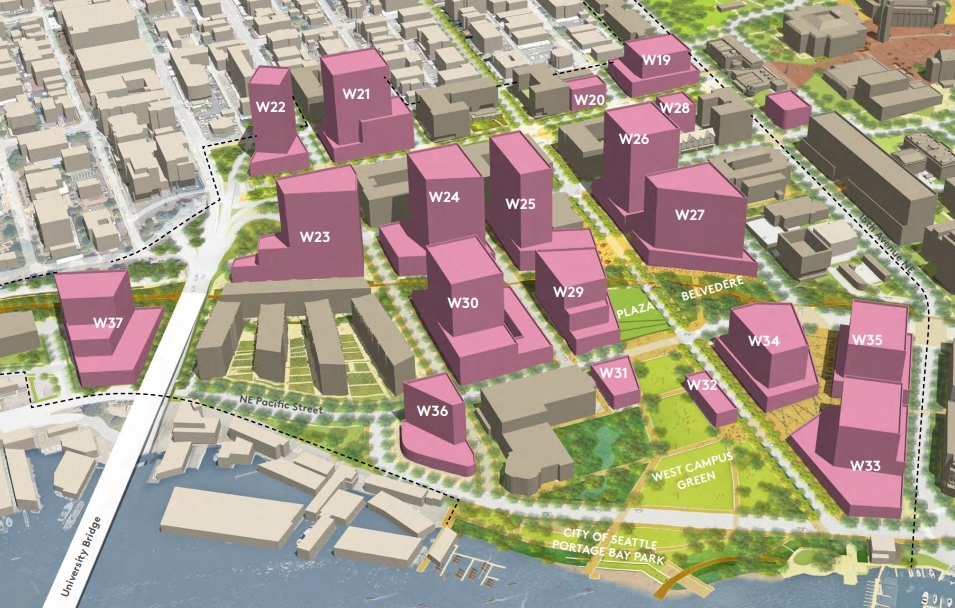
UW has also shown more progress towards their commitment to sustainability through their investment in alternative modes of transportation. This includes the development of pedestrian-friendly crosswalks to encourage cycling and walking on and around campus. Additionally, to promote using accessible transportation on campus, UW has partnered with bikeshare and scooter venders which gives riders affiliated with UW a 50% off discount. By lowering the price of bikes, students will have more of an incentive to use them. This year, UW plans on opening bike houses in three locations across campus, which will have a total capacity of 300 bikes. These efforts not only reduce congestion but also contribute to the university’s environmental goals.
Furthermore, carpooling and ridesharing are becoming more than just buzzwords on campus. UW is increasing its encouragement for students and staff to participate in carpooling programs. Carpools are offered discounted parking on campus as well as given reserved parking stalls.
For those who don’t have carpool options, UW encourages students to ride the bus. On Sept. 1, 2022, UW implemented a new transportation demand management strategy. Since then, all riders under the age of 18 can ride the bus for free thanks to the state “Move Ahead Washington” transportation package. In the past year, all 22,900 campus employees have also been covered with access to free U-Passes, an expansion covering more than 10,000 non-unionized employees.
If bussing isn’t convenient, UW also offers intercampus shuttles between medical centers as well as a NightRide shuttle to get students who live on or off campus home safely. These options provide students with convenient ways to get around while meeting UW’s environmental goals.
Continuous Feedback and Adaptation
UW seeks feedback from students and the community regarding their transportation experiences. Through their annual survey and traffic report, the university is able to understand traffic volumes and measure different forms of transportation. By listening to concerns and making necessary adjustments, UW aims to create a transportation system that evolves to meet the changing needs and modes of transportation. Based on last year’s survey, the university plans on developing neighborhood commute plans for high populated zip codes around the U District. Additionally, UW intends to upgrade 60 locations with scooter docking locations to address the rising number of electric scooters on campus.
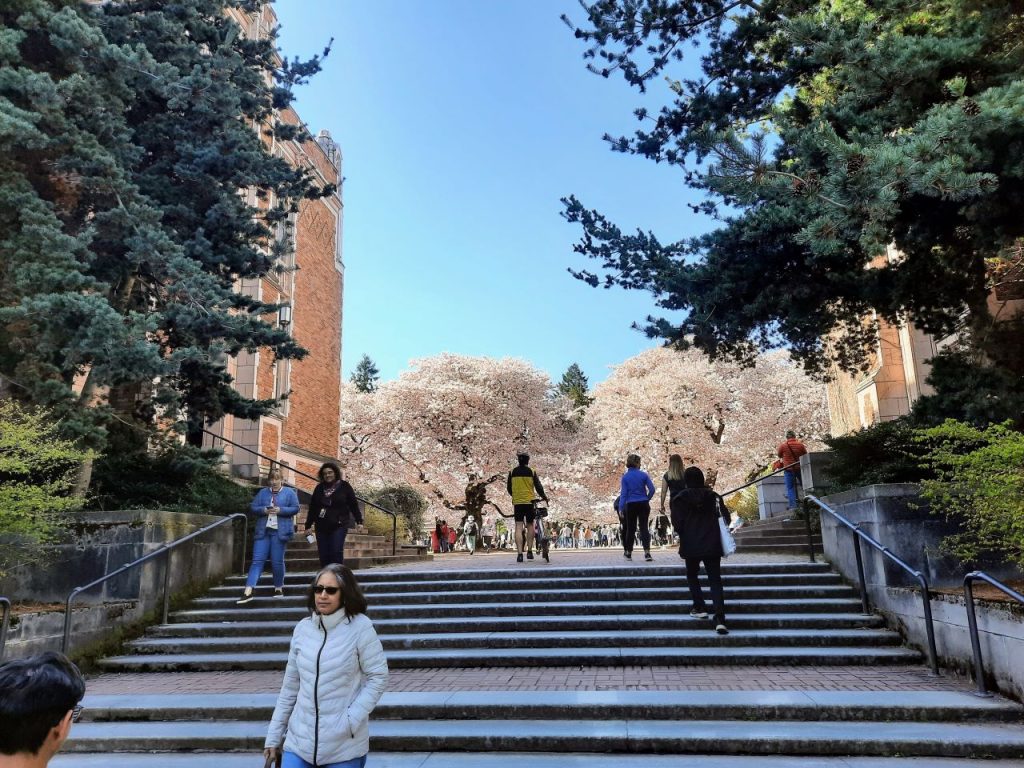
UW’s 2022 transportation survey results show them well below the cap set in the Campus Master Plan:
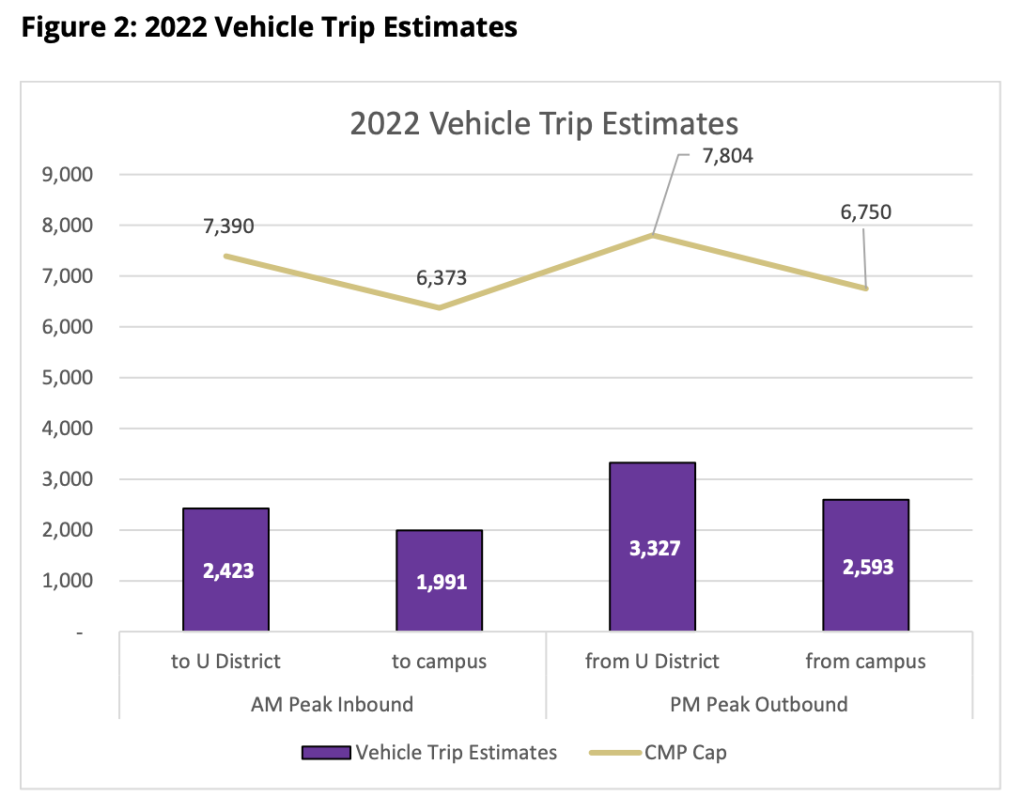
As the University of Washington’s Campus Master Plan for transportation unfolds, it stands as a testament to the institution’s dedication to improvement. At the same time, it showcases the voices of the people who pushed UW towards a greener future.

Marina Blatt (Guest Contributor)
Marina Blatt is a Seattle resident and a student at the University of Washington. She is currently working towards a double major in Philosophy and Journalism and Public Interest Communication, reflecting her passion for critical thinking and addressing the public’s needs. Marina is committed to advocating for a more sustainable and optimistic future.

